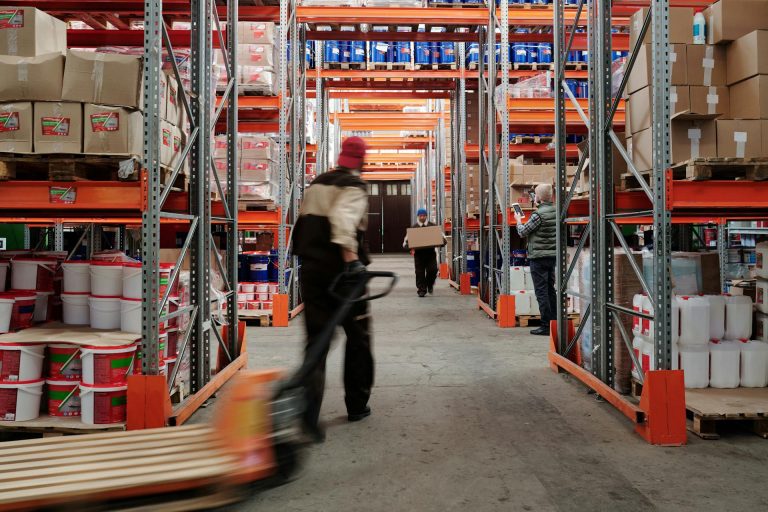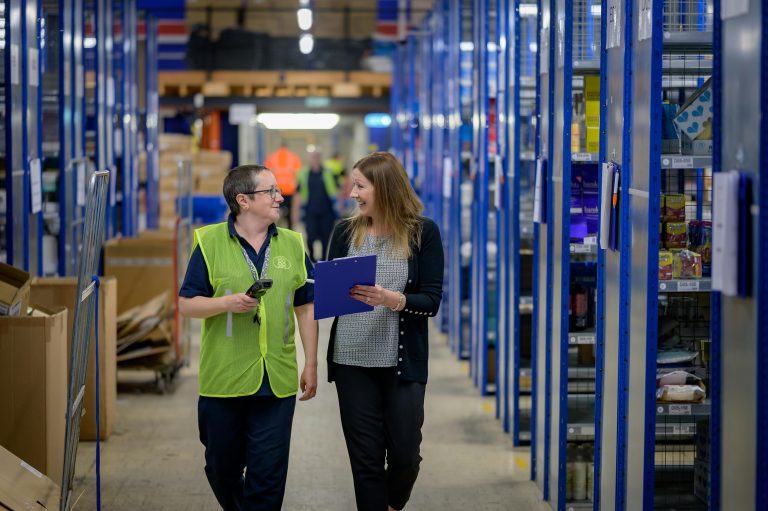The main objective of warehouse technology should be to simplify and bring visibility, but If you tried to keep track of all the buzzwords and tech that revolve around possible warehouse solutions, you’d have to open a new warehouse to manage it.
If we were discussing your warehouse we would quickly begin to narrow down the specifics that could help your business, so we’ll use the next best thing: a general breakdown of considerations to decide what technology can help any warehouse.
The Evolution of Warehouse Technology
Over the years, warehouse technology has evolved significantly, transforming traditional manual operations into streamlined, data-driven processes. From the early days of pen and paper-based inventory management to the advanced systems of today, technology has revolutionized the way warehouses operate. Can you point to those changes in your space?
Understanding the Costs and Return on Investment
Before making any investment, it is essential to consider the costs involved and the potential return on investment (ROI). Implementing warehouse technology does come with upfront expenses, including hardware, software, implementation, and training costs. However, when evaluating the ROI, it is important to look beyond the initial investment and consider the long-term benefits in terms of improved efficiency, reduced errors, and increased inventory tracking.
Enhancing Efficiency and Streamlining Operations
Warehouse technology plays a pivotal role in enhancing efficiency and streamlining warehouse operations. Automated processes, such as barcode scanning, automated sorting, and conveyor systems, enable faster and more accurate order fulfillment. With technology-driven optimization, warehouses can handle higher order volumes, resulting in increased productivity and reduced lead times.
Improved Inventory Management and Accuracy
One of the biggest challenges in warehouse management is maintaining accurate inventory records. Warehouse technology, such as 2D Barcodes and Barcode scanning systems, greatly improves inventory accuracy. Real-time tracking of inventory levels ensures better control over stock, reduces the risk of stockouts, and eliminates the need for manual stock checks.
Real-Time Data and Analytics
Warehouse technology provides access to real-time data and advanced analytics, offering valuable insights into warehouse operations. Data-driven decision-making enables proactive inventory management, identifies process bottlenecks, and helps optimize workflows. Through data analysis, warehouses can identify trends, predict demand, and make informed decisions to improve overall efficiency.
Automation and Robotics in Warehousing
Automation and robotics have revolutionized warehouse operations, driving efficiency and reducing manual labor requirements. Automated storage and retrieval systems (AS/RS) allow for efficient space utilization and fast order picking. Robotics and autonomous vehicles assist in tasks such as palletizing, goods transportation, and even order fulfillment. The integration of these technologies optimizes workflows, reduces human error, and improves operational speed.
Warehouse Technology and Labor Optimization
Implementing warehouse technology does not necessarily mean replacing human workers. Instead, it allows businesses to optimize their workforce by automating repetitive tasks and reallocating resources to more value-added activities. By streamlining operations and reducing manual labor requirements, warehouse technology enables companies to allocate their human resources more strategically, increasing overall productivity.
Integration and Compatibility Considerations
When implementing warehouse technology, it is crucial to consider integration with existing systems. Compatibility between new and legacy systems, such as warehouse management systems (WMS), enterprise resource planning (ERP) systems, and inventory management software, is essential for seamless operations. Choosing technology that integrates well with the existing IT infrastructure ensures smooth implementation and starts with finding expert inventory consultants.
Overcoming Challenges in Implementing Warehouse Technology
While the benefits of warehouse technology are substantial, implementation can come with its share of challenges. Some common obstacles include resistance to change, the complexity of integrating new systems, and the need for employee training. By addressing these challenges proactively and involving key stakeholders in the decision-making process, businesses can overcome obstacles and ensure successful implementation.
Scalability and Future Growth
When evaluating warehouse technology, scalability is a crucial factor to consider. As businesses grow and evolve, their warehouse requirements change. Choosing scalable technology ensures that the system can adapt to increased order volumes, expanding product lines, and changing operational needs. Scalable solutions provide the flexibility necessary to accommodate future growth without significant disruptions or costly system replacements.
Warehouse Technology Security and Data Protection
As warehouses become more digitized, data security and protection are paramount. Warehouse technology relies on interconnected systems and data sharing, which increases the risk of cyber threats and data breaches. It is essential to prioritize robust security measures, including firewalls, encryption, access controls, and regular system audits, to safeguard sensitive information and maintain the integrity of warehouse operations.
Warehouse Management Systems (WMS)
Warehouse management systems (WMS) are comprehensive software solutions designed to optimize and control warehouse operations. WMS software provides functionalities such as inventory tracking, order management, labor optimization, and reporting. By implementing a WMS, warehouses can achieve better inventory accuracy, streamlined workflows, and improved overall operational efficiency.
Warehouse Technology and Sustainability Initiatives
Warehouse technology can contribute to sustainability initiatives in several ways like Energy-Efficient Lighting Systems, Renewable Energy Integration, Green Packaging Solutions, and Waste Management and Recycling. These initiatives often have additional subsidies or tax benefits that can benefit the planet while also saving your business some green.
Internet of Things (IoT) in Warehousing
The Internet of Things (IoT) has revolutionized the way warehouses collect and leverage data. IoT devices, such as sensors and RFID tags, enable real-time tracking of goods, monitor environmental conditions, and facilitate predictive maintenance. By harnessing IoT in warehousing, businesses can gain actionable insights, optimize inventory management, and enhance overall operational efficiency.
B2B eCommerce Portals
Warehouse based businesses often miss out on maximized revenue due to underutilized sales channels like Portals and online stores. Portals provide immediate access for existing and new customers, and these technologies can be integrated directly into many existing WMS to further reduce the time involved for order processing and fulfillment.
Warehouse Technology for Order Fulfillment
Speaking of fulfillment, efficient order fulfillment is crucial for customer satisfaction and business success. Warehouse technology, such as automated picking systems, barcode scanning, and optimized order routing, significantly improves order accuracy and speed. By leveraging these technologies, warehouses can ensure timely and error-free order processing, leading to increased customer satisfaction and loyalty.
Warehouse Technology for Supply Chain Visibility
Warehouse technology plays a vital role in providing end-to-end visibility across the supply chain. By integrating systems such as WMS, ERP, and transportation management systems (TMS), businesses can gain real-time insights into inventory levels, order status, and shipment tracking. Enhanced supply chain visibility enables better decision-making, reduces lead times, and improves collaboration with suppliers and customers.
Warehouse Technology and Customer Satisfaction
In today’s customer-centric marketplace, meeting and exceeding customer expectations is paramount. Warehouse technology contributes to customer satisfaction by enabling faster order processing, accurate order fulfillment, and on-time delivery. Real-time inventory visibility and improved order accuracy instill confidence in customers, leading to repeat business and positive brand reputation.
Warehouse Technology and Sustainability
Sustainability is a growing concern for businesses across industries. Warehouse technology can contribute to sustainability efforts by optimizing energy usage, reducing waste, and enabling more efficient resource allocation. Automated systems, for example, can optimize routing to minimize fuel consumption, while IoT sensors can monitor environmental conditions to prevent spoilage and minimize waste.
Warehouse Technology Implementation Best Practices
Implementing warehouse technology successfully requires careful planning and execution. Some best practices to consider include:
- Conducting a thorough needs analysis and aligning technology with business goals.
- Collaborating with vendors and experts to select the right technology solutions.
- Developing a detailed implementation plan with clear timelines and milestones.
- Providing comprehensive training to employees to ensure smooth adoption and utilization of technology.
- Regularly monitoring and evaluating the effectiveness of implemented technology and making necessary adjustments.
Training and Employee Adoption Strategies
Employee training and adoption are critical to the successful implementation of warehouse technology. Strategies to ensure smooth adoption include:
- Communicating the benefits of technology to employees and addressing concerns.
- Providing comprehensive training programs tailored to different roles and responsibilities.
- Encouraging open communication and feedback to address challenges and improve the adoption process.
- Incentivizing employees to embrace technology by highlighting the positive impact on their work environment and job satisfaction.
FAQs: Answering Common Questions about Warehouse Technology
What are the main benefits of implementing warehouse technology?
Implementing warehouse technology offers several benefits, including improved efficiency, streamlined operations, enhanced inventory management, real-time data insights, and labor optimization. It enables businesses to meet customer expectations, increase productivity, and achieve cost savings.
How do I calculate the return on investment (ROI) for warehouse technology?
To calculate ROI for warehouse technology, consider factors such as labor savings, improved order accuracy, reduced lead times, and increased customer satisfaction. Compare the upfront costs with the long-term benefits and projected cost savings to determine the ROI.
What are the potential challenges in implementing warehouse technology?
Implementing warehouse technology may face challenges such as resistance to change, compatibility issues with existing systems, employee training, and ensuring seamless integration. Overcoming these challenges requires effective communication, collaboration, and proactive planning.
How does warehouse technology contribute to sustainability?
Warehouse technology contributes to sustainability by optimizing energy usage, reducing waste, and enabling efficient resource allocation. Automated systems minimize fuel consumption, IoT sensors prevent spoilage, and data analytics optimize resource utilization, leading to more sustainable warehouse operations.
What considerations should businesses keep in mind when choosing warehouse technology?
When choosing warehouse technology, businesses should consider factors such as scalability, integration capabilities, compatibility with existing systems, long-term cost implications, and the vendor’s reputation and support services. It is crucial to select technology solutions that align with specific business needs and goals.
How can warehouse technology enhance customer satisfaction?
Warehouse technology enhances customer satisfaction by enabling faster order processing, accurate order fulfillment, and improved supply chain visibility. Real-time inventory tracking, streamlined order routing, and on-time delivery contribute to a positive customer experience and build trust in the brand.
Takeaway
Warehouse technology will continue to play a transformative role in warehouse operations, and each business needs to take a proactive approach to how they will use technology now and down the road.
So, how much warehouse technology is worth it? The answer lies in your business objectives, operational needs, and long-term vision. With proper planning, implementation, and ongoing optimization, warehouse technology can keep your business ahead of the times.



